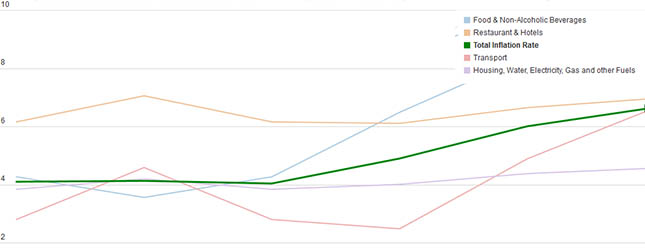Business journalists have a distinct advantage over other aspiring data journalists; economic data is released regularly and on time. By simply updating a database of excel spreadsheet each time new financial data is released, data journalists can create compelling visuals that explain economic trends.
That is, unless they simply copy and paste the figures into their articles. On August 29, the Kenya Bureau of Statistics released its monthly inflation statistics. Capital FM published almost verbatim the information from the press release. The Standard provided more in-depth data about the causes behind inflation rates for transportation. Bloomberg news included a link to a chart of Kenya’s inflation rate over the last 10 months.
As the press release only focused on changes in inflation rates from July to August, a key piece of missing information is how the change over one month fits in with larger trends. By focusing in on the sectors that saw the largest jump in inflation: restaurant and hotel, housing, utilities, transport and food journalists can chart the indices pushing up inflation over time:
http://cf.datawrapper.de/Dn9Q5/1/The Standard coverage, which delves deeper into the rising cost of petrol, diesel and kerosene, could create a similar chart tracking those prices in order to contextualize The Energy Regulatory Commission (ERC)’s explanation of the price change. Similarly, the Capital FM story, focused more on food prices, could create a visual charting the trends in feeding a family of four for a day by multiplying the costs for items used in a typical day by the price for each of those items as provided each month in the inflation report to visualize the trend.
Despite the impact that inflation rates and economic indicators have on the average Kenyan, coverage tends to be targeted at an audience already specialized in business and finance. Simply updating graphic templates with current financial data enables ordinary citizens to quickly understand financial reports in the context of the overall growth of the Kenyan economy.
The final challenge is to visualize how other economic factors, including currency value, lending rates and economic growth, impact the overall health of the economy.


